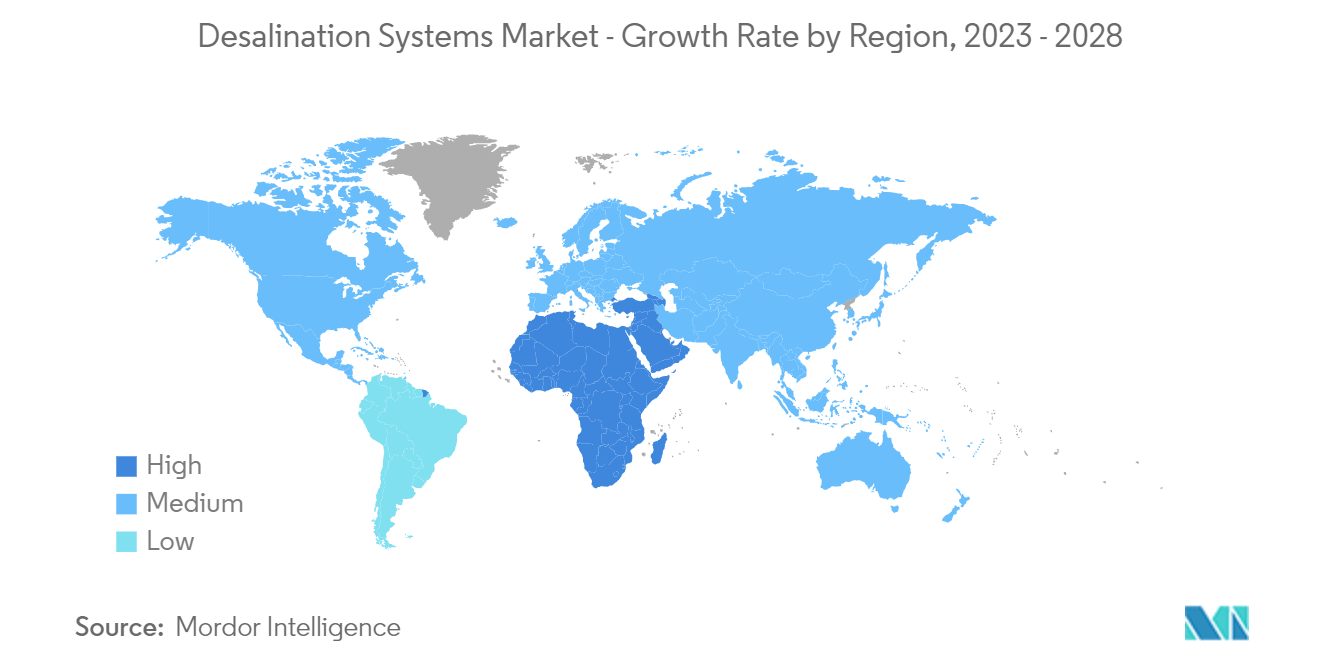Market Trends of Desalination System Industry
Municipal Application to Dominate the Market
- Municipal application accounts for the highest percentage of desalination systems in installed plants. The world is in need of fresh water, and 97% of the water on earth is salted, with an average salinity of 3.5%, which is way too high for drinking, industry, or agriculture.
- Water is fundamental to life, yet sustainable freshwater resources are increasingly limited in quantity and quality. Population growth, changing water consumption patterns, and climate change threaten freshwater sources.
- The majority of the existing plants are handled by municipal departments in various countries. For instance, the Middle East & Africa get their fresh water supply from desalination plants. Over 90% of the water supply is supplied by municipal corporations in these regions.
- A Memorandum of Understanding (MoU) was signed between Morocco’s government and the OCP group in 2023, aiming to provide the cities of Safi, El Jadida, and neighboring regions with drinkable water using seawater desalination.
- According to a statement from the Ministry of Logistics and Water, operations in the Safi seawater desalination plant have commenced. The plan has an ambitious aim of producing approximately 10 million cubic meters of drinking water in the year 2023.
- In India, in 2023, in a bid to meet Mumbai’s burgeoning water demand, the Brihanmumbai Municipal Corporation (BMC) has rolled out tenders on the ambitious desalination plant project.
- The project is at an estimated cost of INR 13,028 crore (USD 1582.358 million). The civic body seeks to design and build the project over the course of the next three years. The data furnished by the civic body shows that while the estimated cost for the first phase of the project is INR 5,625 crore (USD 683.2 million), the second phase, which seeks to expand the plant to a capacity of 400 MLD, is estimated at INR 7,404 crore (USD 899.2 million).
- Therefore, all the above-mentioned factors help in the growth of desalination systems for municipal application.

Middle East and Africa Dominates the Market
- The Middle East and Africa emerged as the largest market for desalination systems. The demand for desalination systems in the region is mainly due to the growing demand for desalinized water for drinking and industrial and agricultural use.
- In addition to this, growing population, rapid urbanization, and limited availability of surface water have increased in countries such as Saudi Arabia, UAE, Egypt, Iran, Kuwait, Oman, and South Africa, among others; this has, in turn, increased the consumption of fresh water, which is driving the demand for desalination systems in the region.
- Saudi Arabia is classified as one of the most water-scarce nations on the planet. Saudi Arabia is among the world’s largest consumers of water, next to the United States and Canada, with daily water consumption of 250 liters per capita.
- To meet the demand, Saudi Arabia has become the largest producer of desalinated water worldwide, accounting for 25% of the global supply. It is home to the world’s largest desalination plants.
- In March 2022, Saudi Arabia announced more than 60 water projects worth SAR 35 billion (USD 9.33 billion) that will strengthen the Kingdom’s position as the world’s largest water desalination market, as reported at the 3rd MENA Desalination Projects Forum 2022.
- After completion, these projects are expected to increase the desalination capacity to 7.5 million cubic meters of water per day by 2027, from 2.54 cubic meters per day in 2021, nearly tripling the capacity in six years.
- Recently, Algeria has faced severe drought due to the decrease in rainfall in the country over the last decade, which is between 30% and 40%, which made the policymakers expand plans of desalination to meet the daily needs of both households and industrial applications.
- Algeria is home to Africa’s largest desalination plant, the HammaSeawater Desalination Plant, with a freshwater production capacity of 200,000 cubic meters per day.
- In October 2022, the Emirates Water and Electricity Company (EWEC) received proposals from three companies for the development of a seawater desalination plant in Abu Dhabi. Spanish infrastructure group Acciona, France’s Engie, and GS Inimah have shown interest in building the Shuweihatplant, which will supply up to 70 million imperial gallons daily in Abu Dhabi's Al Dhafra region.
- Thus, all the factors mentioned above impact the demand for desalination systems in the Middle East and Africa region.


